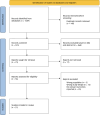Post-traumatic stress disorder and symptoms in paediatric cancer survivors and their family nucleus: systematic review, meta-analysis and meta-regression
- PMID: 39523667
- PMCID: PMC11698174
- DOI: 10.1192/bjo.2024.805
Post-traumatic stress disorder and symptoms in paediatric cancer survivors and their family nucleus: systematic review, meta-analysis and meta-regression
Abstract
Background: Various studies have highlighted the increased incidence and symptoms of depression and anxiety in paediatric cancer survivors (PCS). Yet no meta-analysis has focused on post-traumatic stress disorder (PTSD) or post-traumatic stress symptoms (PTSS) in PCS and their family nucleus.
Aims: To evaluate the overall risk of PTSD and severity of PTSS in PCS and their family nucleus. Secondary objectives include identifying potential risk factors of PTSD and high PTSS.
Method: We systematically searched PubMed, Embase and PsycINFO for studies comparing the risk of PTSD and PTSS severity among PCS, their family nucleus and non-cancer controls. PRISMA reporting guidelines were followed. Random effects meta-analyses and meta-regressions were conducted.
Results: From 1089 records, we included 21 studies. PCS have an increased risk of PTSD (risk ratio 2.36, 95% CI 1.37-4.06) and decreased PTSS severity (standardised mean difference -0.29, 95% CI -0.50 to -0.08). Subgroup analyses of other categorical study-level characteristics revealed that female PCS who were older at diagnosis and data collection had a significantly higher risk of PTSD. Meta-regression were insignificant. Family nucleus did not show a significantly increased risk of PTSD (risk ratio 1.13, 95% CI 0.59-5.00) and PTSS severity (standardised mean difference 0.53, 95% CI -0.00 to 1.06). Systematically reviewing studies on the family nucleus found that the majority reported a significantly increased risk of psychological trauma compared with the comparator. Lower education, income and social status were also risk factors.
Conclusions: Timely identification and interventions are imperative for policy makers and healthcare providers to prevent trauma from worsening in this population group.
Keywords: Trauma and stressor-related disorders; carers; child and adolescent psychiatry; meta-analysis; systematic review.
Conflict of interest statement
None.
Figures





References
-
- Bray F, Laversanne M, Weiderpass E, Soerjomataram I. The ever-increasing importance of cancer as a leading cause of premature death worldwide. Cancer 2021; 127(16): 3029–30. - PubMed
-
- Ahomäki R, Gunn ME, Madanat-Harjuoja LM, Matomäki J, Malila N, Lähteenmäki PM. Late psychiatric morbidity in survivors of cancer at a young age: a nationwide registry-based study. Int J Cancer 2015; 137(1): 183–92. - PubMed
Publication types
LinkOut - more resources
Full Text Sources

